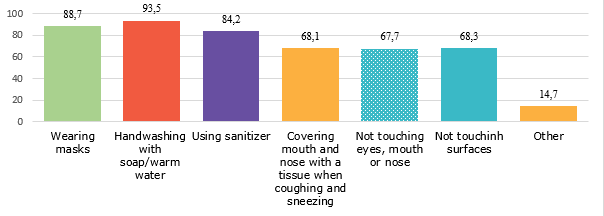About 76% of Kyrgyzstan’s households affected by COVID-19
Publications: 18.02.2021
The “Follow-up assessment of COVID-19 – Impact on Children in Kyrgyzstan” has been conducted by the National Statistics Committee, with financial and technical support of UNICEF.
The headline number is part of the data from a household survey on the impact of COVID-19 on the situation of children and women in Kyrgyzstan, conducted in November-December 2020 by the National Statistics Committee with the financial and technical support of the United Nations Children's Fund (UNICEF), presented today. The survey covered the period from March 2020 until the day of the survey. Of the 4,310 addresses selected for the survey, 3,976 households were inhabited at the time of the survey, of which 3,869 answered the questionnaire.
Over three of out four households (76%) were affected by COVID-19, having faced at least one of the difficulties that occurred during the pandemic. Among these difficulties, a decrease in household income ranked first affecting 50.7% of the households, followed by dissatisfaction with remote learning from the parents or guardians of children (31.8%), a family member having contracted COVID-19 or died from it (28.6%), an adult household member feeling emotional distress (20.4%), among other reasons.
Households affected by COVID-19
(in percent)

More than 28% of households were covered by social support / assistance, among which more than 79% received it from government agencies.
Regarding newborns and pregnant women, prenatal care was provided to 100% of women aged 15-49 who gave birth to a live child in the last year, and antenatal care was provided by a doctor (about 84%) or by nurses, midwives and paramedics (more than 16%). Among women who gave birth to a live child in the past 12 months, 89% of women had four or more antenatal visits. At least two vital observations were received by 99.8% of newborns in the first two days after birth.
After the birth of a child, about 65% of women in labor were in a medical institution from 12 hours to 4 days. At the same time, after discharge from the medical institution, only 11% of newborns were visited for postnatal observation in the first two days and 47% in the first six days.
The results of the survey showed that sensitive care for children aged 2-4 years was carried out mainly by any adult member of the household (94.7%), but the father's participation (12.6%) was very limited. The number of children aged 3-4 years participating in early education programs was 7.1%. About 15% of children under the age of five were left alone for more than an hour or in the care of another child under the age of 10 at least once during the last week.
Among the preschool children who attended preschool educational institutions before the outbreak of coronavirus infection, about 29% used the provided television programs and digital platforms for development.
According to the survey data, more than 86% of households have children aged 0-17 years, and almost every second household had at least one child under the age of 5 years. Distance learning covered about 83% of children aged 7-17 years and the share of children whose parents are not satisfied with the online learning process was 78 percent.
Reasons for dissatisfaction with the online learning process
(in percent)

Finally, regarding COVID-19 preventive measures, the proportion of children whose parents discussed with their children taking precautions to reduce the risk of COVID-19 infection was more than 98%.
Awareness measures discussed with children
(in percent)

For reference:
The National Statistical Committee of the Kyrgyz Republic informs that, as part of the study of the impact of coronavirus infection on the population, two independent surveys, "Impact of COVID-19 on households" and "Impact of Covid-19 on the situation of children and women in Kyrgyzstan" were conducted. For each survey, independent samples and individual questionnaires were used.
The survey "Impact of Covid-19 on the situation of children and women in Kyrgyzstan" is aimed at a detailed study of the coverage of antenatal and postnatal care for mothers and children, early childhood development, child education during a pandemic, as well as studying the issues of financial situation and social support of households and teaching children precautions to reduce the risk of contracting Covid-19.
Household - a person or a group of persons living together in a dwelling and providing themselves with everything necessary for life through a common household, fully or partially pooling and spending their funds. These persons may be linked by marriage and family relations, kinship relations, or without the presence of such a relationship.
______________________________________________________________________________________________________
|
Household Statistics Division |
| e-mail: Y.Kalymbetova@stat.kg; | Tel. + 996 (312) 324655 |
When using official statistics data and corresponding metadata, users are obliged to refer to their source (Article 30 of the Law "On Official Statistics").




